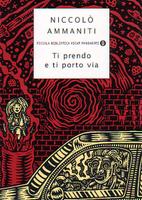 Set in a imprecise town not far from Rome, whose name recalls some real touristy resorts on the Tirreno sea, this novel narrates two parallel stories of a boy and a man: Pietro, a quiet and imaginative boy of 12, and Graziano, the epitome of the hippy playboy. The two protagonists have no more than one initial common point: the village of Iscano Scalo.
Set in a imprecise town not far from Rome, whose name recalls some real touristy resorts on the Tirreno sea, this novel narrates two parallel stories of a boy and a man: Pietro, a quiet and imaginative boy of 12, and Graziano, the epitome of the hippy playboy. The two protagonists have no more than one initial common point: the village of Iscano Scalo.
Graziano left his hometown to satisfy his thirst for adventure, and, after years of nomadic life, decides to go back home and implement one of his latest odd fantasies: open a jeans shop and get married in the attempt to rediscover the bliss of the provincial life. He is an exuberant man, full of contradictory feelings and principles. His odd obsessions and fantasies will direct him into grotesque situations and affairs, hilarious but also pathetic.
Pietro lives with his family in Iscano Scalo, and attends the local secondary school. He is as sweet as irresolute. This lack of confidence will be the catalyst factor leading to the appalling outcome of the novel. His personality is counter posed by the brilliant and a bit arrogant persona of his best girl-friend, coming from a higher social status. Pietro has got some enemies,
too. Evil and unscrupulous schoolmates will persecute their easiest target, Pietro, arising our resentments and sympathies. They will be in fact the primary cause of Pietro's troubles. Often depicted with a caricature taste, their leader embodies the features of the classical delinquent
of the village, with a distressed background and a complex personality.
The suspense is successfully created by a regular alternated rhythm: one chapter is dedicated to Graziano, the following one to Pietro. In between, many subplots, in the form of digressions chronicling anecdotes and stories about the other residents, complete the picture of the life in Iscano Scalo. Graziano's life always runs parallel to Pietro's (dis)adventures without interweaving with him, except for a small incident. However, they BOTH enjoy the sympathy of the tolerant reader, and other indirect connections (namely, the solitary and introvert Pietro's
teacher) will bring their destinies somehow close. Shifts in time contribute to convey an achieved sense of suspension as well. The novel starts with the unexpected failure of Pietro at school, but this event is, in chronological terms, one of the last scenes of the novel. The spotlight moves then months back and focuses on Graziano's return. Another cinematographic flash back brings us some months earlier into the turbulent life of Graziano on the Adriatic Riviera.*
Ammaniti is certainly the obtrusive author, but unobtrusive narrator of the events. If he orchestrates coincidences, encounters and destinies of his creatures [the novel is told in third person], it is not, in fact, the narrator's judgmental point of view what transpires. Multiple viewpoints of the inhabitants of Iscano Scalo emerge in the novel through the skilful filter of the narrator's pen. Their voice, their beliefs and prejudices, even their inner fears and desires [direct reported thoughts are highlighted in italics in the text] are what we actually perceive. The result is an in-depth introspection rendered without spending too many descriptive words.
The novel is pervaded by a strong humour and fanciful references to the current popular Italian culture, which, together with the violent and turbulent writing and some shocking episodes, make this book an enjoyable and gripping reading with a disturbing denouement. One of the last scenes, when Pietro finds shelter in a quagmire after the bad news of his failure at school, emphasises with a powerful visual effect this moment of anguish. The real
protagonist of this book, however, is Iscano Scalo and its damned inhabitants compelled to live a frustrated, bored and senseless life. Pietro's brother dreams to escape to Alaska,Graziano tries to flee to Jamaica and Pietro promises to her friend that one day he will "take her and bring her away" (= "ti prendo e ti porto via"). Iscano Scalo can be the metonymy of the sad
condition of the trapped man, but, before acquiring this existentialist connotation, it is, firstly, the fictional mirror of a real microcosmic society.
To conclude, I quote one of my favourite Italian novelists and epistemologists of the last century, Italo Calvino:
"There are two ways to escape suffering the inferno where we live everyday:
the first is easy for many: accept the inferno and become such a part of
it that you can no longer see it. The second is risky and demands constant
vigilance and apprehension: seek and learn to recognise who and what, in
the midst of the Inferno, are not inferno, then make them endure, give them space."**
Pietro found a third solution: "he cut his life in two to get rid of it".***
* The Adriatic Riviera is known to be the favourite leisure destination of party loafers since the 60s.
** Italo Calvino, Invisible Cities, London, Vintage Classics, 1999, p.165. Translation by William Weaver. (Original title: Italo Calvino, Le città invisibili).
*** Nicolo Ammaniti, Ti prendo e ti porto via, Milano, Oscar Mondadori, 1999, p.451.
 Good Morning [finally a nice sunny morning after the windy and rainy day of yesterday],
Despite the adverse weather, yesterday night has been very pleasant. I went to my *officially* last Spanish class, and our professora, who is from Buenos Aires, brought us hand-made empanadas as a gift [they are typical *pastries* similar to a small calzone filled with meat&veg or spinach&cheese ~ photo attached]. !Que deliciosas!
After the class, all our class headed to the local Spanish restaurant where we drank sangria, ate all sorts of tapas and chatted a lot... in Spanish, of course. Also the waiters had been instructed to speak only in Spanish to us. During the dinner the teacher went through some food-related execercises, we took some pictures, and shared the tapas.
By the end of the dinner, I was tipsy and got very chatty. My *Spanglish* got better and better.
A great night! And the cool thing is that some of us, in September, will start meeting up once a week at our teacher's place to carry on, mainly with conversation.
Good Morning [finally a nice sunny morning after the windy and rainy day of yesterday],
Despite the adverse weather, yesterday night has been very pleasant. I went to my *officially* last Spanish class, and our professora, who is from Buenos Aires, brought us hand-made empanadas as a gift [they are typical *pastries* similar to a small calzone filled with meat&veg or spinach&cheese ~ photo attached]. !Que deliciosas!
After the class, all our class headed to the local Spanish restaurant where we drank sangria, ate all sorts of tapas and chatted a lot... in Spanish, of course. Also the waiters had been instructed to speak only in Spanish to us. During the dinner the teacher went through some food-related execercises, we took some pictures, and shared the tapas.
By the end of the dinner, I was tipsy and got very chatty. My *Spanglish* got better and better.
A great night! And the cool thing is that some of us, in September, will start meeting up once a week at our teacher's place to carry on, mainly with conversation.
 Here are my companeros: from the left, me; our teacher Patricia; Jimi from Scotland; Juan from London; Zuza from Bratislava; Amanda & Naomi from London; Ohan & Ghili from Israel.
Here are my companeros: from the left, me; our teacher Patricia; Jimi from Scotland; Juan from London; Zuza from Bratislava; Amanda & Naomi from London; Ohan & Ghili from Israel.





